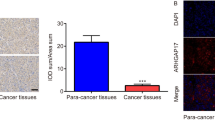Abstract
SEPT2 plays an important role in cell division through its effect on cytoskeletons. It is a GTP-binding protein and can also form filament with SEPT6 and SEPT7. Knockdown of SEPT2, 6, and 7 causes stress fibers to disintegrate and then cells lose polarity and divide abnormally. Increasing evidence has shown that septins are related to the regulation of cell proliferation. In this study, the expression of SEPT2 was first identified to be up-regulated in human hepatoma carcinoma cells (HCC). In addition, SEPT2 was found to be phosphorylated on Ser218 by casein kinase 2 (CK2), which was also overexpressed in HCC. By overexpressing SEPT2 and its S218A mutant in SMMC7721 and L02 cell lines, we confirmed that the phosphorylation of SEPT2 on Ser218 by CK2 was crucial to the proliferation of HCC. These results suggest that SEPT2 might be a promising target for liver cancer therapy.




Similar content being viewed by others
References
Longtine MS, DeMarini DJ, Valencik ML et al (1996) The septins: roles in cytokinesis and other processes. Curr Opin Cell Biol 8:106–119. doi:10.1016/S0955-0674(96)80054-8
Kinoshita M, Kumar S, Mizoguchi A et al (1997) Nedd5, a mammalian septin, is a novel cytoskeletal component interacting with actin-based structures. Genes Dev 11:1535–1547. doi:10.1101/gad.11.12.1535
Xue J, Tsang CW, Gai WP et al (2004) Septin 3 (G-septin) is a developmentally regulated phosphoprotein enriched in presynaptic nerve terminals. J Neurochem 91:579–590. doi:10.1111/j.1471-4159.2004.02755.x
Spiliotis ET, Nelson WJ (2006) Here come the septins: novel polymers that coordinate intracellular functions and organization. J Cell Sci 119:4–10. doi:10.1242/jcs.02746
Spiliotis ET, Kinoshita M, Nelson WJ (2005) A mitotic septin scaffold required for mammalian chromosome congression and segregation. Science 307:1781–1785. doi:10.1126/science.1106823
Kremer BE, Haystead T, Macara IG (2005) Mammalian septins regulate microtubule stability through interaction with the microtubule-binding protein MAP4. Mol Biol Cell 16:4648–4659. doi:10.1091/mbc.E05-03-0267
Nagata K, Inagaki M (2005) Cytoskeletal modification of Rho guanine nucleotide exchange factor activity: identification of a Rho guanine nucleotide exchange factor as a binding partner for Sept9b, a mammalian septin. Oncogene 24:65–76. doi:10.1038/sj.onc.1208101
Kremer BE, Adang LA, Macara IG (2007) Septins regulate actin organization and cell-cycle arrest through nuclear accumulation of NCK mediated by SOCS7. Cell 130:837–850. doi:10.1016/j.cell.2007.06.053
Hall PA, Russell SH (2004) The pathobiology of the septin gene family. J Pathol 204:489–505. doi:10.1002/path.1654
Johnson ES, Gupta AA (2001) An E3-like factor that promotes SUMO conjugation to the yeast septins. Cell 106:735–744. doi:10.1016/S0092-8674(01)00491-3
Xue J, Wang X, Malladi CS et al (2000) Phosphorylation of a new brain-specific septin, G-septin, by cGMP-dependent protein kinase. J Biol Chem 275:10047–10056. doi:10.1074/jbc.275.14.10047
She YM, Huang YW, Zhang L et al (2004) Septin 2 phosphorylation: theoretical and mass spectrometric evidence for the existence of a single phosphorylation site in vivo. Rapid Commun Mass Spectrom 18:1123–1130. doi:10.1002/rcm.1453
Qi M, Yu W, Yu L (2005) Septin1, a new interaction partner for human serine/threonine kinase aurora-B. Biochem Biophys Res Commun 336:994–1000. doi:10.1016/j.bbrc.2005.06.212
Litchfield DW (2003) Protein kinase CK2: structure, regulation and role in cellular decisions of life and death. Biochem J 369:1–15. doi:10.1042/BJ20021469
Guo C, Yu S, Davis AT, Green JE, Ahmed K (2001) A potential role of nuclear matrix-associated protein kinase CK2 in protection against drug-induced apoptosis in cancer cells. J Biol Chem 276:5992–5999. doi:10.1074/jbc.M004862200
Wang G, Unger G, Ahmad KA et al (2005) Downregulation of CK2 induces apoptosis in cancer cells—a potential approach to cancer therapy. Mol Cell Biochem 274:77–84. doi:10.1007/s11010-005-3077-1
Wang G, Ahmad KA, Ahmed K (2005) Modulation of receptor mediated apoptosis by CK2. Mol Cell Biochem 274:201–205. doi:10.1007/s11010-005-2952-0
Gonzalez ME, Peterson EA, Privette LM et al (2007) High SEPT9_v1 expression in human breast cancer cells is associated with oncogenic phenotypes. Cancer Res 67:8554–8564. doi:10.1158/0008-5472.CAN-07-1474
Wang G, Ahmad KA, Ahmed K (2006) Role of protein kinase CK2 in the regulation of tumor necrosis factor-related apoptosis inducing ligand-induced apoptosis in prostate cancer cells. Cancer Res 66:2242–2249. doi:10.1158/0008-5472.CAN-05-2772
Acknowledgments
This work was supported by the National 973 program of China (2004CB518605), 863 projects of China (2006AA020501, 2008ZX100002-020, 2008ZX10208), the Project of the Shanghai Municipal Science and Technology Commission (03dz14086) and the National Natural Science foundation of China (30024001, 30771188).
Author information
Authors and Affiliations
Corresponding author
Rights and permissions
About this article
Cite this article
Yu, W., Ding, X., Chen, F. et al. The phosphorylation of SEPT2 on Ser218 by casein kinase 2 is important to hepatoma carcinoma cell proliferation. Mol Cell Biochem 325, 61–67 (2009). https://doi.org/10.1007/s11010-008-0020-2
Received:
Accepted:
Published:
Issue Date:
DOI: https://doi.org/10.1007/s11010-008-0020-2




